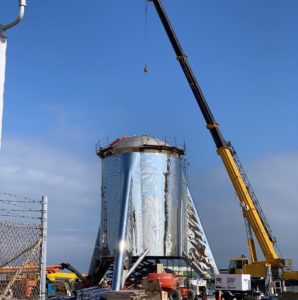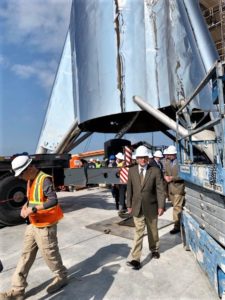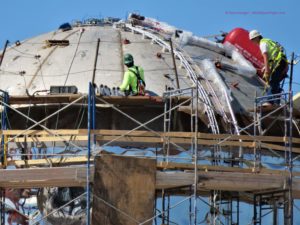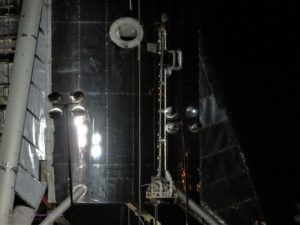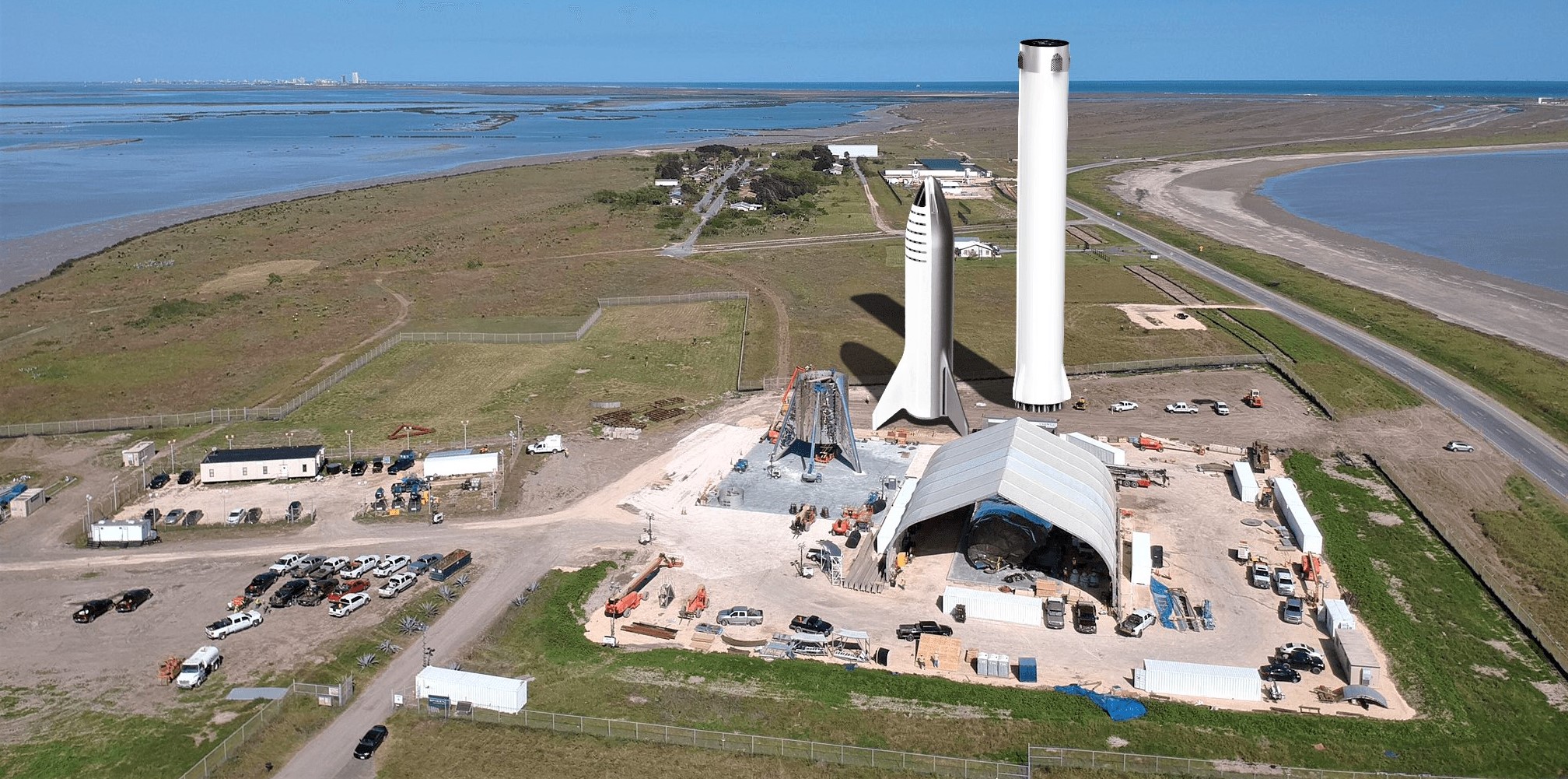
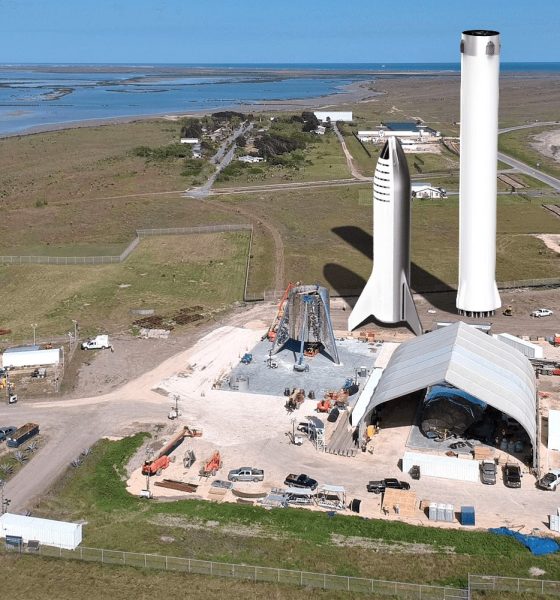
SpaceX
SpaceX job posts confirm Starship’s Super Heavy booster will be built in Texas
A duo of SpaceX job postings at the company’s South Texas facilities have confirmed that both Starship and Super Heavy “flight article” vehicles will initially be fabricated and assembled on-site in Boca Chica, also implying that the rocket’s first orbital launch attempts will occur in the same vicinity.
Construction of the first massive Super Heavy booster could begin in Boca Chica within the next several months, presumably progressing in a similar fashion to Starship’s full-scale hopper prototype. According to CEO Elon Musk, Starhopper hop tests and Super Heavy construction could begin – respectively – as early as March and April 2019, perhaps just one or two months from now.

Where to build a giant rocket?
“Tank fabricators will work to build the primary airframe of the Starship and Super Heavy vehicles at the SpaceX South Texas build site. [They] will work with an elite team of other fabricators and technicians to rapidly build the tank (cylindrical structure), tank bulkheads, and other large associated structures for the flight article design of both vehicles.” – SpaceX, 02/15/19
Posted on February 15th, both open positions centered around structural assembly (i.e. welding) critical for the construction of the massive propellant tank domes, barrel sections, and other major structure of Starship and Super Heavy. Following an unanticipated pivot to stainless steel – rather than advanced carbon composites – as the primary structural material of choice for BFR, the project has been continually marked by a flurry of impressive technical progress at the same time as many previously foundational aspects became uncertain.
Most notably, SpaceX appeared to terminate a lease agreement it had held with the Port of Los Angeles for a large berth meant to be developed into a dedicated factory for BFR’s massive spaceship upper stage and booster, whose 9m (~30 foot) diameter would have been highly impractical to build somewhere that wasn’t either at the rocket’s launch site or directly adjacent to a port. With its headquarters in Hawthorne, CA (southwestern Los Angeles), SpaceX’s first choice was unsurprisingly the Port of LA, a location that would have allowed its 5000+ local employees to have seamlessly transferred to the BFR program without requiring highly disruptive relocations.
The source info is incorrect. Starship & Raptor development is being done out of our HQ in Hawthorne, CA. We are building the Starship prototypes locally at our launch site in Texas, as their size makes them very difficult to transport.
— Elon Musk (@elonmusk) January 16, 2019
Known as Berth 240, SpaceX’s lease began in March 2018 but was reportedly terminated in January 2019, likely meaning that the company will have to vacate the premises next month. While an official SpaceX statement and subsequent Elon Musk tweets relating to that report served to partially correct the record and confirm that “Starship prototypes” would be built locally in South Texas, Super Heavy was never mentioned. SpaceX’s latest job postings complete the image, indicating that all aspects of the first Starship and Super Heavy prototypes will be assembled in South Texas.
Weighing just shy of 4.5 million kilograms (~10M lbs) fully-fueled and standing around 118m (387 ft) tall with both stages stacked together, BFR is a beast of a launch vehicle and will require wholly new methods of production and assembly thanks to its sheer scale and the extensive integration of stainless steel alloys into its design. Compared to SpaceX’s Falcon 9 rocket, which is by no means small, Super Heavy on its own could end up being 68m (224 ft) tall, just slightly shorter than a complete Falcon 9 with a booster, upper stage, and fairing (71m, 233 ft). Standing on its tripod fins, Starship stands around 55m (180 ft) tall, although all of these figures are liable to change, as they come from a September 2018 SpaceX presentation that occurred before Musk publicized the move to stainless steel.
Ask and you shall receive! Here's an image with the mighty #SaturnV compared to the @SpaceX's upcoming #Starship and #Superheavy stack! Really gives a sense of scale how truly massive the rocket will be! 🤯
This and many of my other renders are now also available at my shop! pic.twitter.com/qTscwzWyKF
— Kimi Talvitie (@kimitalvitie) January 12, 2019
Likely to remain unchanged is the diameter of Starship and Super Heavy: 9m (30 ft), roughly 2.5 times wider than Falcon 9’s booster and upper stage. Even more true for a 9m-diameter rocket also meant to rely on a partial implementation of stainless steel balloon tanks, transporting Starship and Super Heavy more than a few thousand feet horizontally is going to be an extraordinary challenge, although SpaceX’s Boca Chica facilities are conveniently located just a mile or less from the Gulf of Mexico. While road transport is entirely out of the question, Saturn V’s massive first and second stage boosters proved to be relatively easy to transport thanks to the production facility being directly adjacent to a large body of water (or a river to get there, in their case).
“For all their prodigious bulk, [Saturn V’s 33.0 ft (10.1 m) diameter first and second stages] could be transported with comparative ease via seagoing barges [from Michoud, Louisiana to Cape Canaveral, Florida].” – Roger Bilstein/NASA, p. 301
Assuming SpaceX chooses to assemble Super Heavy with the same vertical, outdoors approach, Boca Chica, Texas is going to be greeted by a view even more exotic than the already-impressive progress being made with Starship’s Starhopper prototype. CEO Elon Musk noted that he believed the first Super Heavy prototype would begin to be built this spring (as early as April). In the meantime, SpaceX continues to exploit the benefits of stainless steel whenever it can, utilizing the company’s wealth of Hawthorne, CA expertise and infrastructure to fabricate subassemblies that can easily be shipped by road or plane to South Texas. After arrival, Boca Chica-based employees or contractors can be tasked with the considerably less infrastructure-intensive work of final assembly and integration, a challenging and critical process but one that is at least slightly more setting-agnostic.
- Local representatives were given tours of SpaceX’s Boca Chica facilities and work earlier this week. (Alex Dominguez – 02/10/19)
- (Bobby Guerra – 02/11/19)
- Aerospace-grade bubble wrap! (NASASpaceflight – bocachicagal)
- Much like Falcon 9, Starhopper has begun to be outfitted with plumbing necessary to pressurize and fill its propellant tanks, among other things. (NASASpaceflight – bocachicagal)
SpaceX’s propulsion team continues to test the first full-scale Raptor engine a few hundred miles north of Boca Chica while Starhopper is gradually outfitted with a range of avionics, wiring, and plumbing needed for the vehicle’s hop test debut. That could come as early as March, according to Musk, although further delays should come as no surprise.
Check out Teslarati’s newsletters for prompt updates, on-the-ground perspectives, and unique glimpses of SpaceX’s rocket launch and recovery processes!

Elon Musk
Starlink passes 9 million active customers just weeks after hitting 8 million
The milestone highlights the accelerating growth of Starlink, which has now been adding over 20,000 new users per day.

SpaceX’s Starlink satellite internet service has continued its rapid global expansion, surpassing 9 million active customers just weeks after crossing the 8 million mark.
The milestone highlights the accelerating growth of Starlink, which has now been adding over 20,000 new users per day.
9 million customers
In a post on X, SpaceX stated that Starlink now serves over 9 million active users across 155 countries, territories, and markets. The company reached 8 million customers in early November, meaning it added roughly 1 million subscribers in under seven weeks, or about 21,275 new users on average per day.
“Starlink is connecting more than 9M active customers with high-speed internet across 155 countries, territories, and many other markets,” Starlink wrote in a post on its official X account. SpaceX President Gwynne Shotwell also celebrated the milestone on X. “A huge thank you to all of our customers and congrats to the Starlink team for such an incredible product,” she wrote.
That growth rate reflects both rising demand for broadband in underserved regions and Starlink’s expanding satellite constellation, which now includes more than 9,000 low-Earth-orbit satellites designed to deliver high-speed, low-latency internet worldwide.
Starlink’s momentum
Starlink’s momentum has been building up. SpaceX reported 4.6 million Starlink customers in December 2024, followed by 7 million by August 2025, and 8 million customers in November. Independent data also suggests Starlink usage is rising sharply, with Cloudflare reporting that global web traffic from Starlink users more than doubled in 2025, as noted in an Insider report.
Starlink’s momentum is increasingly tied to SpaceX’s broader financial outlook. Elon Musk has said the satellite network is “by far” the company’s largest revenue driver, and reports suggest SpaceX may be positioning itself for an initial public offering as soon as next year, with valuations estimated as high as $1.5 trillion. Musk has also suggested in the past that Starlink could have its own IPO in the future.
News
SpaceX shades airline for seeking contract with Amazon’s Starlink rival

SpaceX employees, including its CEO Elon Musk, shaded American Airlines on social media this past weekend due to the company’s reported talks with Amazon’s Starlink rival, Leo.
Starlink has been adopted by several airlines, including United Airlines, Qatar Airways, Hawaiian Airlines, WestJet, Air France, airBaltic, and others. It has gained notoriety as an extremely solid, dependable, and reliable option for airline travel, as traditional options frequently cause users to lose connection to the internet.
Many airlines have made the switch, while others continue to mull the options available to them. American Airlines is one of them.
A report from Bloomberg indicates the airline is thinking of going with a Starlink rival owned by Amazon, called Leo. It was previously referred to as Project Kuiper.
American CEO Robert Isom said (via Bloomberg):
“While there’s Starlink, there are other low-Earth-orbit satellite opportunities that we can look at. We’re making sure that American is going to have what our customers need.”
Isom also said American has been in touch with Amazon about installing Leo on its aircraft, but he would not reveal the status of any discussions with the company.
The report caught the attention of Michael Nicolls, the Vice President of Starlink Engineering at SpaceX, who said:
“Only fly on airlines with good connectivity… and only one source of good connectivity at the moment…”
CEO Elon Musk replied to Nicolls by stating that American Airlines risks losing “a lot of customers if their connectivity solution fails.”
American Airlines will lose a lot of customers if their connectivity solution fails
— Elon Musk (@elonmusk) December 14, 2025
There are over 8,000 Starlink satellites in orbit currently, offering internet coverage in over 150 countries and territories globally. SpaceX expands its array of satellites nearly every week with launches from California and Florida, aiming to offer internet access to everyone across the globe.
Currently, the company is focusing on expanding into new markets, such as Africa and Asia.
News
Tesla hints at Starlink integration with recent patent
“By employing polymer blends, some examples enable RF transmission from all the modules to satellites and other communication devices both inside and outside the vehicle.”

Tesla hinted at a potential Starlink internet terminal integration within its vehicles in a recent patent, which describes a vehicle roof assembly with integrated radio frequency (RF) transparency.
The patent, which is Pub. No U.S. 2025/0368267 describes a new vehicle roof that is made of RF-transparent polymer materials, allowing and “facilitating clear communication with external devices and satellites.”
Tesla believes that a new vehicle roof design, comprised of different materials than the standard metallic or glass elements used in cars today, would allow the company to integrate modern vehicular technologies, “particularly those requiring radio frequency transmission and reception.
Tesla has recently filed a US patent application on integrating RF transparent materials into the roof structure.
“facilitating clear communication with external devices and satellites”
Tesla fleet is getting @Starlink connectivity integration soon. LFG @Tesla @elonmusk… pic.twitter.com/bLa8YtPLd1
— Chansoo Byeon (@Chansoo) December 9, 2025
Instead of glass or metallic materials, Tesla says vehicles may benefit from high-strength polymer blends, such as Polycarbonate, Acrylonitrile Butadiene Styrene, or Acrylonitrile Styrene Acrylate.
These materials still provide ideal strength metrics for crashworthiness, stiffness for noise, vibration, and harshness control, and are compliant with head impact regulations.
They would also enable better performance with modern technologies, like internet terminals, which need an uninterrupted signal to satellites for maximum reception. Tesla writes in the patent:
“By employing polymer blends, some examples enable RF transmission from all the modules to satellites and other communication devices both inside and outside the vehicle.”

One of the challenges Tesla seems to be aware of with this type of roof design is the fact that it will still have to enable safety and keep that at the forefront of the design. As you can see in the illustration above, Tesla plans to use four layers to increase safety and rigidity, while also combating noise and vibration.
It notes in the patent that disclosed examples still meet the safety requirements outlined in the Federal Motor Vehicle Safety Standards (FMVSS).
Starlink integrated directly into Tesla vehicles would be a considerable advantage for owners. It would come with a handful of distinct advantages.
Initially, the inclusion of Starlink would completely eliminate cellular dead zones, something that is an issue, especially in rural areas. Starlink would provide connectivity in these remote regions and would ensure uninterrupted service during road trips and off-grid adventures.
It could also be a critical addition for Robotaxi, as it is crucial to have solid and reliable connectivity for remote monitoring and fleet management.
Starlink’s growing constellation, thanks to SpaceX’s routine and frequent launch schedule, will provide secure, stable, and reliable internet connectivity for Tesla vehicles.
Although many owners have already mounted Starlink Mini dishes under their glass roofs for a similar experience, it may be integrated directly into Teslas in the coming years, either as an upgrade or a standard feature.
